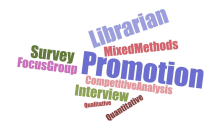Denise Leyton
Posts tagged with qualitative
Showing 31 - 40 of 43 items

When developing or reconsidering a library service, sometimes you can get stuck in your head. You go back and forth with your colleagues proposing different ways of doing things. You model out different scenarios, do an environmental scan, read the literature, weigh pros and cons but you still can’t decide how to proceed. A great way to figure out how to move forward is to go to your users for feedback by employing intercept interviews.

Continuing the discussion about survey design (see Let's Talk about Surveys, Part 1), you’ve decided a survey is an appropriate methodology for what you want to find out and are thinking about what questions you want to ask. But how you ask these questions and structure them within the survey itself, as well as the question formats and options you give people for responding all require careful consideration.

Doing a survey is often the default research method thought of when you need to answer questions about what people like, expect, or want, among other things. While surveys are likely to be considered the easiest option, you can’t conflate “easy to create” with “easy to create well.” Even if a survey is an appropriate methodology for the question you’re looking to answer, the questions you ask, the way you ask them, and the options you give people for responding all require a thoughtful approach.

“Learning from Advanced Student Staff Experiences” was a University of Michigan Library study conducted in 2017, integrating methodologies of user-centered design and critical librarianship.

In this study, engineering librarians Leena Lalwani, Jamie Niehof, and Paul Grochowski sought to learn from graduate students in the College of Engineering (CoE) how these students could benefit from more instruction on U-M Library resources.

In the second of two posts, Informationists from the Taubman Health Sciences Library share their research project to improve library integration within the U-M School of Nursing curriculum. Using a mixed methods approach, they are investigating undergraduate student information seeking needs and behaviors.

In two blog posts, Informationists from the Taubman Health Sciences Library share their research project to improve library integration within the U-M School of Nursing curriculum. Using a mixed methods approach, they are investigating undergraduate student information seeking needs and behaviors.

Ask a Librarian email and instant messaging (IM) service providers targeted current users of our virtual reference services during 2016-2017, to gather feedback about our online research and reference service. We wanted to know more about users' motivation for seeking help via email and via IM, as well as users' satisfaction with their online interactions. Additionally, we were interested in gathering users' ideas for future IM service enhancements.

Like many academic research libraries, the University of Michigan Library has a promotion process for its librarians. And, like many libraries, the policies need to be reviewed on occasion. The Promotion and Appointment of Librarians (PAL) Task Force was charged by the Librarians’ Forum with reviewing our promotion process and making recommendations to better align what we do with the goals of both individuals and the Library. This Task Force utilized various qualitative and quantitative research methods to get the best data (described below).

There are many ways to record and analyze what is happening in the University of Michigan libraries over time. The more we understand how users are engaging with our spaces, the more we can do to meet their needs. But how do you get a handle on such a big question (library space use)? What data do you collect and how do you break it down?